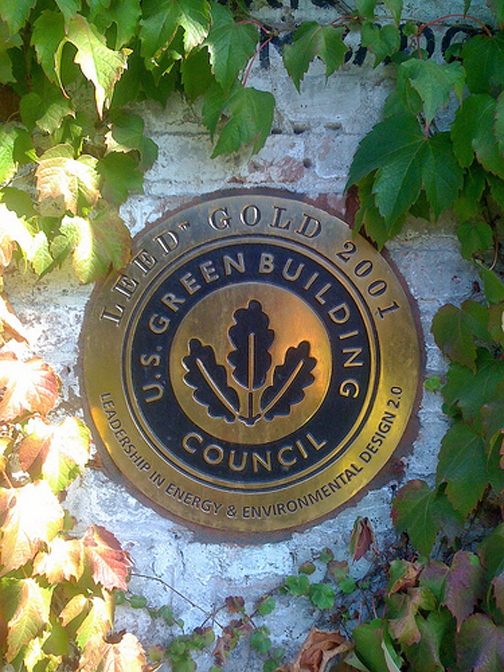
Image Credit: Sam Beebe / Flickr
One of the key features of the LEED rating systems is that, after satisfying minimum program requirements and prerequisites, project teams may select from the available compilation of LEED credits. Providing those options is key, not only because there is no one homogenous building type, but also because owners may have certain specific sustainable features they wish to pursue.
But surprising to some, there is one LEED credit that stands out, by far, as the least earned.
Accepting that the LEED system is no longer restricted to new construction projects, and in an effort to compare apples with apples, this analysis looked at the LEED New Construction v2009 rating system.
To provide some context, credit NC v2009 EA c1, Optimize Energy Performance, was the most often achieved credit: over 97 percent of the time. That is, it was achieved on 3,927 of the 4,039 projects certified under this rating system. And that may not be surprising, given the weight that LEED places on reducing energy use.
But NC-2009 MR c6, Rapidly Renewable Materials, was earned in just 2 percent of certified projects. It was achieved only 87 times in the 4,039 projects.
Again, for more context, no other credit was achieved is so few projects (only in double digits). That is, the next nearest credit was achieved more than a hundred times.
What the credit requires
So, what does NC-2009 MR c6, Rapidly Renewable Materials, require? “Use rapidly renewable building materials and products for 2.5% of the total value of all building materials and products used in the project, based on cost. Rapidly renewable building materials and products are made from agricultural products that are typically harvested within a 10-year or shorter cycle.”
The intent of the credit is noble: “To reduce the use and depletion of finite raw materials and long-cycle renewable materials by replacing them with rapidly renewable materials.”
But even to the casual observer, there is a disconnect between that idealistic goal and actual buildings, because it is the rare building that contains any meaningful quantity of cotton, wool, wheatboard, strawboard, cork, corn, rubber, or agrifiber.
There is no USGBC list of acceptable agricultural products, but be aware there is a USGBC-issued LEED interpretation (Interpretation #10057) that states that the plants must be “typically regenerated” within 10 years. The interpretation is a bit cryptic. Farmed trees can be harvested within 10 years, but because harvesting trees in 10 years isn’t typical, that lumber might not meet this standard.
Also, LEED Interpretation #2549 says that to count as rapidly renewable for the purposes of this credit, the material must be harvested without causing the animal (assuming an animal is the source of the material) harm, and the animal must be able to continue to regenerate the material. (A good example is wool from a sheep.)
It’s still important
Despite the fact that the credit is almost never achieved, some have suggested that it is important because materials credits play an ever-increasing and controversial role in LEED v4. Not that this v2009 credit is a prequel to a v4 credit (it is not), but rather that USGBC staff weighs the pros and cons of rapidly renewable materials differently than the marketplace. For example, it has been suggested that using corn as a plastic substitute in building is similar to the using corn in ethanol versus as food.
These credits for materials are complex, involving issues such as transparency and life-cycle analysis. This complexity is now apparent in the reworking of the v4 materials credits. And maybe it is not so bad that corn has not become a significant building material. (The role of corn in fuel is uncertain, as EPA has acknowledged that the statutory ethanol mandate cannot be met.)
You can register LEED 2009 projects through October 31, 2016, and pursue MRc6 for years thereafter, bettering the 2 percent statistic. But in lieu of corn, consider wool carpeting and agrifiber products like particleboard and plywood. (Yes, they qualify).
Stuart Kaplow is an environmental attorney. This column was originally posted at Green Building Law Update. Kaplow is legal counsel and past chair of the U.S. Green Building Council Maryland.
Weekly Newsletter
Get building science and energy efficiency advice, plus special offers, in your inbox.















2 Comments
Leed
I'm left wracking my brain for what commonly used building materials I could substitute plywood and OSB for.
Taking a longer view, Im not sure much of this is very helpful. For instance, the introduction of sheep in Scotland caused not only the deforestation of almost all of the Highlands, but also the introduction of the Enclosure Acts leading to the Highland Clearances and the social dislocation that still affects the country today. So wool is good for those with short memories.
bamboo!!
Bamboo!!!!
Log in or create an account to post a comment.
Sign up Log in